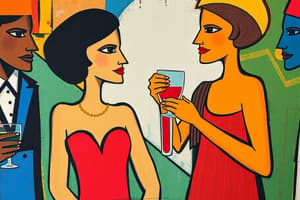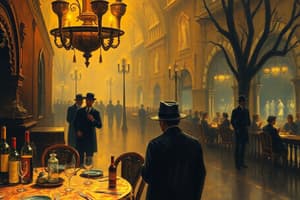Podcast
Questions and Answers
Which of the following groups were targeted during the "Red Scare" of 1919-1920?
Which of the following groups were targeted during the "Red Scare" of 1919-1920?
- Left-wingers (correct)
- Right-wingers
- Moderate politicians
- Business tycoons
The "Red Scare" led to the deportation of over six thousand suspected radicals.
The "Red Scare" led to the deportation of over six thousand suspected radicals.
True (A)
What event in June 1919 intensified the "Red Scare"?
What event in June 1919 intensified the "Red Scare"?
The bombing of the Washington, D.C. headquarters.
The trial of Sacco and Vanzetti, which resulted in their execution, lasted for ______ years.
The trial of Sacco and Vanzetti, which resulted in their execution, lasted for ______ years.
Match the following terms with their definitions:
Match the following terms with their definitions:
Which of the following groups were NOT mentioned as being among the most recent arrivals who were eager to keep stimulants out of the hands of blacks?
Which of the following groups were NOT mentioned as being among the most recent arrivals who were eager to keep stimulants out of the hands of blacks?
The passage suggests that immigrant workers were often divided by ethnic differences and unable to unite around common goals like wages and working conditions.
The passage suggests that immigrant workers were often divided by ethnic differences and unable to unite around common goals like wages and working conditions.
What specific vice was associated with the ubiquitous Western saloon that contributed to the push for prohibition?
What specific vice was associated with the ubiquitous Western saloon that contributed to the push for prohibition?
Despite the overwhelming ratification of the "dry" amendment, strong opposition persisted in the larger ______ cities.
Despite the overwhelming ratification of the "dry" amendment, strong opposition persisted in the larger ______ cities.
Match the following terms with their definitions based on the context of the passage:
Match the following terms with their definitions based on the context of the passage:
What was the main sentiment among Americans in the 1920s?
What was the main sentiment among Americans in the 1920s?
The American economy was heavily reliant on foreign trade during the 1920s.
The American economy was heavily reliant on foreign trade during the 1920s.
What were some of the new technologies and forms of entertainment that contributed to the 'roaring twenties'?
What were some of the new technologies and forms of entertainment that contributed to the 'roaring twenties'?
The fear of red Russia and the rise of communism in America led to a period of ______, where suspicion and distrust were widespread.
The fear of red Russia and the rise of communism in America led to a period of ______, where suspicion and distrust were widespread.
Match the following events or concepts to their corresponding descriptions:
Match the following events or concepts to their corresponding descriptions:
Which of the following was NOT a factor contributing to the anxieties and fears of the 1920s?
Which of the following was NOT a factor contributing to the anxieties and fears of the 1920s?
Which year marked the end of an era of virtually unrestricted immigration to the United States?
Which year marked the end of an era of virtually unrestricted immigration to the United States?
The 1920s saw a significant increase in immigration to the United States.
The 1920s saw a significant increase in immigration to the United States.
Why did Americans turn inward in the 1920s?
Why did Americans turn inward in the 1920s?
The Immigration Act of 1929 reduced immigration by limiting the total number of immigrants to 152,574 per year.
The Immigration Act of 1929 reduced immigration by limiting the total number of immigrants to 152,574 per year.
What was the primary source of immigrants to the United States during the era of unrestricted immigration before the 1920s?
What was the primary source of immigrants to the United States during the era of unrestricted immigration before the 1920s?
The national-origins quota system was abolished in ______.
The national-origins quota system was abolished in ______.
Match each immigration act with its corresponding annual immigration limit:
Match each immigration act with its corresponding annual immigration limit:
Which of the following were NOT major factors contributing to the formation of ethnic communities in the United States during the 1920s?
Which of the following were NOT major factors contributing to the formation of ethnic communities in the United States during the 1920s?
What was the primary goal of the national-origins quota system?
What was the primary goal of the national-origins quota system?
The Immigration Act of 1965 reduced the annual immigration cap to 170,000.
The Immigration Act of 1965 reduced the annual immigration cap to 170,000.
What was the main point of Bruce Barton's best-selling book, "The Man Nobody Knows"?
What was the main point of Bruce Barton's best-selling book, "The Man Nobody Knows"?
The development of the automobile during the 1920s had a minimal impact on American society and industry.
The development of the automobile during the 1920s had a minimal impact on American society and industry.
What was the main message conveyed to consumers in the "possess today and pay tomorrow" marketing strategy?
What was the main message conveyed to consumers in the "possess today and pay tomorrow" marketing strategy?
What was the nickname given to Charles Lindbergh?
What was the nickname given to Charles Lindbergh?
What was the main impact of Lindbergh's achievement on the aviation industry?
What was the main impact of Lindbergh's achievement on the aviation industry?
The ______ was a significant factor in the increased consumer debt during the 1920s.
The ______ was a significant factor in the increased consumer debt during the 1920s.
Match the following terms with their respective descriptions from the text.
Match the following terms with their respective descriptions from the text.
Radio technology was slower than air travel during the 1920s.
Radio technology was slower than air travel during the 1920s.
Which of these industries experienced significant growth during the 1920s?
Which of these industries experienced significant growth during the 1920s?
The radio was drawing Americans back ______ while other innovations like the automobile were luring them away.
The radio was drawing Americans back ______ while other innovations like the automobile were luring them away.
Match the following radio program features with their associated content:
Match the following radio program features with their associated content:
George H. "Babe" Ruth was more famous during the 1920s than most politicians.
George H. "Babe" Ruth was more famous during the 1920s than most politicians.
What is the significance of Yankee Stadium being known as "the House that Ruth Built"?
What is the significance of Yankee Stadium being known as "the House that Ruth Built"?
Which of these WAS NOT a way that radio contributed to American life during the 1920s?
Which of these WAS NOT a way that radio contributed to American life during the 1920s?
What was the nickname given to the area in lower Broadway where Lindbergh was greeted enthusiastically?
What was the nickname given to the area in lower Broadway where Lindbergh was greeted enthusiastically?
Radio technology existed before World War I.
Radio technology existed before World War I.
Flashcards
Immigration Act of 1924
Immigration Act of 1924
Legislation that significantly restricted immigration, ending nearly unrestricted immigration to the U.S.
Quota System
Quota System
A method used to limit the number of immigrants from specific countries based on national origins.
National-origins quota system
National-origins quota system
A system that established immigration quotas based on the nationality of immigrants who were already in the U.S.
Immigration Act of 1965
Immigration Act of 1965
Signup and view all the flashcards
Quota Cap
Quota Cap
Signup and view all the flashcards
McCarran-Walter Act of 1952
McCarran-Walter Act of 1952
Signup and view all the flashcards
Immigrant Communities
Immigrant Communities
Signup and view all the flashcards
Legislation of 1986
Legislation of 1986
Signup and view all the flashcards
Red Scare
Red Scare
Signup and view all the flashcards
Mitchell Palmer
Mitchell Palmer
Signup and view all the flashcards
Sacco and Vanzetti
Sacco and Vanzetti
Signup and view all the flashcards
Ku Klux Klan (KKK)
Ku Klux Klan (KKK)
Signup and view all the flashcards
Antiredism
Antiredism
Signup and view all the flashcards
Electrocution of Sacco and Vanzetti
Electrocution of Sacco and Vanzetti
Signup and view all the flashcards
Political influence of the KKK
Political influence of the KKK
Signup and view all the flashcards
Diversity and modernity
Diversity and modernity
Signup and view all the flashcards
The Roaring Twenties
The Roaring Twenties
Signup and view all the flashcards
Warren G. Harding's Quote
Warren G. Harding's Quote
Signup and view all the flashcards
Isolationism
Isolationism
Signup and view all the flashcards
American Standard of Living
American Standard of Living
Signup and view all the flashcards
Immigration Restriction
Immigration Restriction
Signup and view all the flashcards
Strike Epidemic
Strike Epidemic
Signup and view all the flashcards
Consumer Culture
Consumer Culture
Signup and view all the flashcards
The Man Nobody Knows
The Man Nobody Knows
Signup and view all the flashcards
Million-dollar gates
Million-dollar gates
Signup and view all the flashcards
Barton’s thesis
Barton’s thesis
Signup and view all the flashcards
Buying on credit
Buying on credit
Signup and view all the flashcards
Consumer economy of the 1920s
Consumer economy of the 1920s
Signup and view all the flashcards
Debt accumulation
Debt accumulation
Signup and view all the flashcards
Babe Ruth's impact
Babe Ruth's impact
Signup and view all the flashcards
Automobile revolution
Automobile revolution
Signup and view all the flashcards
Prohibition
Prohibition
Signup and view all the flashcards
Eighteenth Amendment
Eighteenth Amendment
Signup and view all the flashcards
Ethnic Enclaves
Ethnic Enclaves
Signup and view all the flashcards
Labor Unions
Labor Unions
Signup and view all the flashcards
Ethnic Rivalries
Ethnic Rivalries
Signup and view all the flashcards
Cynical Employers
Cynical Employers
Signup and view all the flashcards
Old World Sociability
Old World Sociability
Signup and view all the flashcards
Reform Movement
Reform Movement
Signup and view all the flashcards
Lone Eagle
Lone Eagle
Signup and view all the flashcards
Lucky Lindy
Lucky Lindy
Signup and view all the flashcards
Radio Revolution
Radio Revolution
Signup and view all the flashcards
Wireless telegraphy
Wireless telegraphy
Signup and view all the flashcards
Guglielmo Marconi
Guglielmo Marconi
Signup and view all the flashcards
Cultural unification
Cultural unification
Signup and view all the flashcards
Amos 'n' Andy
Amos 'n' Andy
Signup and view all the flashcards
Brand-name sponsorship
Brand-name sponsorship
Signup and view all the flashcards
Study Notes
American Life in the "Roaring Twenties" (1919-1929)
- Americans in the 1920s withdrew from foreign relations and domestic economy.
- A surge of new technologies, consumer products, and leisure activities characterized the era.
- Economic prosperity with rising incomes and living standards, but also widespread anxieties about the future and loss of traditional values.
- Fears of communism and radicalism following the Bolshevik Revolution of 1917 ("Red Scare") led to restrictions on immigration and free speech.
- The Ku Klux Klan experienced a resurgence, fueled by nativism and prejudice.
- The 1921 Emergency Quota Act and the 1924 Immigration Act severely restricted immigration based on national origins.
- Prohibition (18th Amendment) and social upheaval led to the rise of organized crime (gangsterism).
- The 1920s saw the rise of mass-consumption, automobile manufacturing, and the growth of the stock market.
- A new generation of American writers emerged, pushing boundaries in literature and exploring diverse perspectives.
- The decade saw significant advancements in technology, including the mass production of automobiles and the rise of radio.
- The 1920s were a period of both prosperity and social conflict, marked by economic growth and rapid cultural changes.
Studying That Suits You
Use AI to generate personalized quizzes and flashcards to suit your learning preferences.




